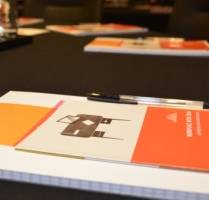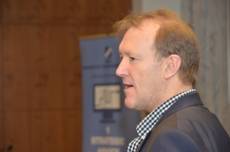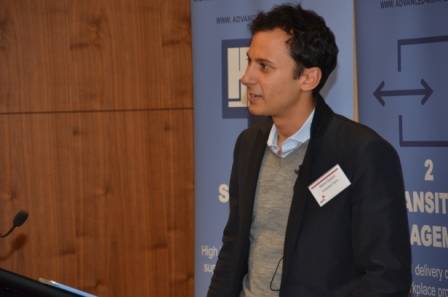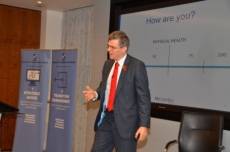November 13, 2014
Workplace Week focuses on the office and individual productivity in all its forms
 The holy grail of improving people’s productivity was the focus of this year’s Workplace Week, which took place last week from 3-7th November and raised more than £12,500 for Children in Need. The annual event organised by AWA and designed as a celebration of workplace innovation, included visits to 11 workplaces showcasing the latest techniques to get people performing at their very best, a day-long convention and a series of Fringe events. Andrew Mawson, who heads up AWA, opened the convention by setting the discussion in context. “We have maximised asset productivity by getting more people into buildings, and therefore working a building harder. But we need to focus on human productivity. If each organisation could make each person just 5 per cent more productive, that would have a major impact both on that organisation and the wider economy. In the knowledge economy we need to get the very best performance out of each and every brain on the payroll and to create the conditions that consciously support that.
The holy grail of improving people’s productivity was the focus of this year’s Workplace Week, which took place last week from 3-7th November and raised more than £12,500 for Children in Need. The annual event organised by AWA and designed as a celebration of workplace innovation, included visits to 11 workplaces showcasing the latest techniques to get people performing at their very best, a day-long convention and a series of Fringe events. Andrew Mawson, who heads up AWA, opened the convention by setting the discussion in context. “We have maximised asset productivity by getting more people into buildings, and therefore working a building harder. But we need to focus on human productivity. If each organisation could make each person just 5 per cent more productive, that would have a major impact both on that organisation and the wider economy. In the knowledge economy we need to get the very best performance out of each and every brain on the payroll and to create the conditions that consciously support that.
While much of the discussion during the day was about the importance of maintaining good physical health within the workplace and its link to productivity, one speaker focused exclusively on mental health. “While we’re happy to talk about physical ailments, mental health – or the lack of it – is taboo,” said Keiron Sparrowhawk, chairman of MyCognition. He talked about how our mental, cognitive, health is inextricably linked to our workplace performance through issues such as attention/ concentration; speed/ accuracy; planning and strategy; memory; and calculation and problem solving. “Being strong in all these areas, and therefore having good cognitive health, gives you – and therefore your employer – a competitive edge in the workplace. Conversely, poor cognitive health is bad for you and your company, reduces your ability to perform and your happiness, leads to absenteeism, early retirement, and misery.”
Poor nutrition and hydration, poor physical health, genetic dispositions and the workplace environment itself all played a role in maintaining people’s mental health, he said, citing examples of people who worked in noisy open-plan offices, with poor air quality, no natural light and bad lighting as heading towards lower cognitive abilities. Pilot trials to measure the effect of a workplace’s layout, space, furniture, noise and light on people’s cognitive health are to be conducted in conjunction with AWA, he added.
But organisational conditions also played a role in improving people’s productivity revealed Eric Barends, CEO of the Centre for Evidence Based Management and Professor Rob Briner of Bath University and The Centre for Evidence Based Management. They catalogued exhaustive research they had undertaken with AWA which revealed the six factors that impact on knowledge workers’ productivity:
• Social cohesion within teams?
• Perceived supervisory support?
• Information sharing?
• Clear and understandable organisational vision and goals
• Strong external communications?
• Trust in team members, supervisors and management?
These and many other topics were discussed by the delegates in small groups in an interactive session, chaired by David Sharp from International Workplace, aimed at rethinking the workplace to put human performance at the top of the priority list in the design and management of the workplace. A flatter management structure; a more prominent role for HR; social and collaborative spaces; an active workplace with wellbeing in mind; approachable leaders; a focus on agile working; an output-based performance system; and the right technology in the right place were all considered to be essential tools for a highly-productive workforce.
These were all things considered by both Invesco and Prostate Cancer UK when they relocated to new offices and took the opportunity to change their working cultures becoming more agile as a result. The convention heard from Owen Sharp, CEO of Prostate Cancer UK, sporting the beginning of a Movember moustache, about the move from the outskirts of Hammersmith to smaller premises near London Bridge. The driver had been to improve relationships, trust and cross-disciplinary working, create more visibility for the charity and improve recruitment and retention. Nobody has their own desk and everyone sits with different people every day which has broken down silos and increased interaction between teams. A variety of different types of space allows people to choose the environment to suit their task. And the move has acted as a catalyst to establish a new identity for the charity which has moved into the top 30 UK charities for the first time. In addition almost half of the staff say they are more productive as a result of the new environment.
The results were similar for Denise Harrison Invesco’s global head of real estate and facilities, when she moved the London office from Finsbury Square to new offices on London Wall. Unlike the charity, agile working was not the initial aim, but became a requirement when the new office, whose lease had already been signed, needed to fit more people than static desks would allow. There was the usual initial reluctance to give up desks, but the introduction of move champions, chosen because they were cynical about the project, smoothed the waters. Nine months down the line there is a 75 per cent satisfaction rate and the experience will be replicated elsewhere in Invesco’s global portfolio.
Both projects showcased during the convention, and throughout the Workplace Week visits, relied on technology to support people to work how and where they performed best. But Misha Gopaul, a founding director of Workplace Fabric, warned that technology had hardly developed compared with what was coming to the workplace soon. He talked about how technology such as room booking systems, temperature sensors, card systems, proximity and thermal sensors and people counters had changed the workplace in the past ten years and how this was expanding. “There are 13 billion devices currently connected to the internet, and that will be 50 billion by 2020. All our devices will be talking to each other all the time. Our physical and digital worlds are merging. Ideas which were futuristic only a few years ago, such as driverless cars and pacemakers which are inserted into the thigh and move automatically into place, are now a reality.”
But he said that the workplace of the future was not just about connected devices, but about how and where people work and where they get their best ideas. “We will move from a cost per square foot or desk view, to is this space facilitating more interactions per sq ft than before.”
The convention concluded with the announcement of a new workplace management framework which “provides a structure for the development and subsequently the assessment of best practice in the management of the workplace”. The framework is designed to be applied to different types of workplaces, particularly high-tech spaces. It will bring the FM function closer to the property, HR, and security teams creating an integrated approach to property management.
The framework which will be officially launched early next year, is based on AWA’s Dr Graham Jervis’s book Moving on …from FM to Workplace Management. The convention heard different speakers talk about how the standard can be used, from supply side to public sector and a global dimension from the RICS. AWA is collaborating with the RICS, the BIFM, the Building Futures Group, and other organisations to develop the new open source tool.
On the Fringe
Workplace Week saw three fringe events take place hosted by office furniture design firms Kinnarps and Herman Miller. They included a briefing on sit/stand working delivered by Rob Stuthridge PhD. He gave arguments for the benefit of adopting sit/stand working within the workplace, focusing on choice rather than the obvious health benefits. He made it clear that standing is not the new ‘right way’ but provides employees with the opportunity to choose whether to work an hour stood up and the next sitting and of course both at different heights thanks to Kinnarps sharply-designed machine leveling tables.
A crowd of more than 50 people were in the audience at the Herman Miller Fringe session to see Oliver Baxter from Herman Miller take a trip down memory lane. He reminded delegates about a publication from 1968 from Robert Propst The Office: A facility Based on Change in which were cited most of what we call activity-based working today.
Workplace visits
Monday
On the Monday of Workplace Week, visitors to Google’s facility on St Giles High Street, saw a mixture of open plan, collaborative space and quiet space support a range of working styles allowing people to choose where they want to work depending on their current activities. Wellbeing is also a theme with a heavily-subsidised massage suite, a 24/7 gym, healthy food and a dog policy to encourage staff to bring their pets to work.
The newly-refurbished nine-storey PWC building at Embankment Place accommodates over 4,000 staff in 3,200 workplaces with 85 per cent occupancy. Delegates learned that hotelling is mandatory for anyone under partner status, with people using kiosks to book and indicate vacant workstations, soon to be available remotely. A welcome desk on each floor is there to resolve any difficulties. The superb facilities for clients and internal meetings, together with the provision of varied break out spaces support the agile working culture, while the IT allowed people to work where they wanted – the firm is currently migrating from laptops to ipads and iphones or users’ own devices.
At asset management firm Invesco on London Wall, visitors saw the first implementation of agile working in the asset management sector which occurred when the firm moved from Finsbury Square to the sixth floor of an iconic building on London Wall but with more staff than initially planned. The shared social space in the centre of the building provides the coffee base for everyone in the office and acts as a hub for all and a place to meet or bump into colleagues more easily. What made the facility stand out to the delegates was the separation of the workplaces from the collaborative space and the fantastic light throughout the building.
Tuesday
Sixteen people visited the London offices of Mintel on the Tuesday of Workplace Week, which the market research firm moved into just over three years ago. The new offices were designed to be exciting environment intended to attract and retain the millenials/ Generation Y. Just over 380 people work across 293 workstations using agile working wherever possible occupying two floors of a six-storey building. There are occasions when they nominate staff specifically to work at home – often two days per week. The décor is very bright and ‘different’. A project break-out space has an American caravan as its refreshments dispensing area (an actual caravan, which was dismantled and re-built to get it on the floor – albeit with the end cut off to fit); one of their meeting rooms is built as the Tardis; and the CEO Peter Haigh told visitors that If he ever had to down-size in space, the one feature he would retain until the last is the main café area where, although he can’t prove it, he feels the interaction generates the greatest ideas and business opportunities. The London office concept is being rolled out to the firm’s offices in Munich, Chicago, Singapore plus other places.
The Guardian newspaper moved to its new home in King’s Cross in December 2008 as an anchor tenant of King’s Place. It created a light, bright, energising environment, with colour-coordinated floors, open plan and short stay desking, breakout spaces, and small offices in the interior of building, so the open plan desks gets the best light. The Guardian included an open staircase in their own demise which has become a wonderful meeting place with open areas for people to sit/chat on each floor adjacent to the staircase. What really impressed the visitors was the way the Guardian used its skill base to support the move. Their food writers researched and proposed the food options for the catering; their editorial team compiled materials about the Kings Cross area and the building facilities and made it very “Guardian”, fitting in with their language and culture. This helped to counteract some initial resistance to the move which was overcome by the Guardian putting a great deal of energy into staff and union involvement in decision making, choices and direction, within an overall vision.
Wednesday
Business lobby group the CBI’s office at Cannon Place, where they occupy one floor of the new multi-tenanted building, was the venue for a tour on the Wednesday of Workplace Week where 16 people saw first-hand how the CBI had managed to successfully engage with their staff and identify, procure and fit-out their new building in eight months. The highlights of the light, bright and colourful modern open-plan office include the reception/member experience area, the non-traditional desk layout, the great use of colour and the fact that the leadership team are setting a great example by sitting out in the open-plan with the rest of the team.
The iconic Lloyd’s building, designed by the Richard Rogers partnership, and known as the Inside-Out Building was familiar to many of the 14 people who attended the visit on the xx of Workplace Week. The building is a leading example of radical Bowellism architecture in which the services for the building, such as ducts and lifts, are located on the exterior to maximise space in the interior. FM Darren Cox and his colleague Bob, a rather grand liveried head waiter, shared their extensive knowledge of the facility, and of Lloyd’s to the group who were captivated by the design, scale and space.
In complete contrast was the Ladbroke Grove office of Innocent Drinks, the food and beverage firm which has made its name from smoothies and veg pots. The firm is sole occupier of a five-storey leased building and has created a very open plan, very modern and whacky environment with Astroturf for carpet and photos of all the staff as babies on the walls in the main communal areas. The lack of hierarchy means that everyone is treated the same and 10 per cent of profits go to charity. The staff also participate in charitable activities and there are numerous inclusive social activities on offer.
Friday
Edelman, the UK’s largest privately-owned PR company, opened the doors of its two-floor office located between Victoria and Westminster home to more than 500 staff on the final day of Workplace Week. The modern layout and design and range of working spaces provides the teams with options to suit their particular work style. With an average age of 26, responding to the needs of Generations Y and Z to ensure they remain working at their best was essential.
Accountancy firm BDO opened the doors of its Baker Street office which was refurbed in 2007. It had previously been occupied by Marks and Spencer before the retailer moved to Paddington Basin. BDO occupies levels two to five, with leel one client meeting rooms and a staff restaurant and levels six and seven currently empty. All 1,600 staff having the same 1800mm desks throughout the entire space, and 8.2 sq m per desk NIA, and no allocated offices. BDO is currently reassessing its space requirements as it needs to maximise space efficiency.
Generously supporting Workplace Week 2014 are Anywhere Working, CoreNet Global, The Chartered Institute for IT, The British Institute of Facilities Management, FM World, i-FM, PFM, OPI, Herman Miller, RICS, FMA, the Xenon Group, Workplace Law, Colebrook Bosson Saunders, Insight, Tomorrow’s FM, FMJ and ThisWeekinFM.com
___________________________________________
 Cathy Hayward is the managing director of Magenta Associates and one of the UK’s foremost writers and commentators on facilities management.
Cathy Hayward is the managing director of Magenta Associates and one of the UK’s foremost writers and commentators on facilities management.
















